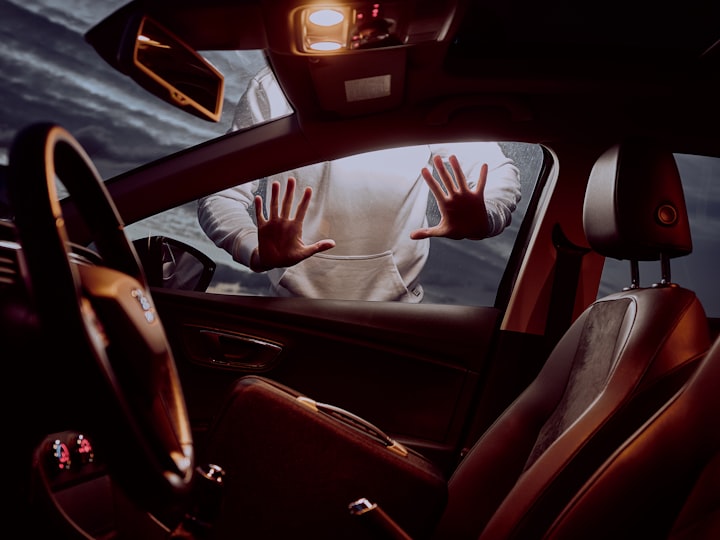
Desensitized.
That’s a big word.
Here’s a story. It was as difficult to write as it is to read.
Norman is a small in stature, slightly rotund, bespectacled middle-aged man. He sits in his compact car, waiting at the curb of a grocery store for his wife to arrive from checkout. It’s a hot summer evening and the sun begins its late descent. The store empties slowly, and the exiting shoppers search for their cars. Trunk lids slam shut. Engines roar to life and fade into the distance of commuter traffic.
Norman suddenly hears a commotion coming from behind on the sidewalk outside the store. Glancing through his rear-view mirror, he notices a young woman in distress. She is struggling to escape the grasp of a strong male hand gripping her arm. She lets out an audible scream, and the remaining figure of a muscular young man appears in the mirror. He grabs the woman by the throat and hurls the woman against the wall, choking her breath away.
Norman leaps from the driver’s seat of his parked car and comes around back to where the assault is taking place. He shouts loudly to draw attention to the scene.
“Hey!”, shouts Norman, “Leave her alone. You’re going to kill her.”
The younger man wheels around, still gripping the throat of his victim. He fixes a wild-eyed gaze on Norman, and let’s go of the girl.
“I’ll leave her alone”, the man growls back. “Why don’t you mind your fucking business old man! I’ll leave her alone.” He begins to stomp toward Norman. “I’ll take care of you instead.”
A menacing look of fury appears on the man’s face as he moves quickly toward the older man. Startled, Norman tries to retreat to the safety of his car. The assailant explodes into a barrage of profanity. A crowd begins to gather around the perimeter of the parking lot.
“Come here, you little fucker! You think you can get away from me?”
Desperate and frightened, Norman tries to start his car, but he is so overcome by the fear of this drug-crazed maniac that he accidentally lets the clutch out, stalling the engine.
The bigger man is now standing at the driver’s side door. A flurry of punches rain in through the open window at Norman’s head. A pre-teenage boy in the back seat tries to block the blows with an outstretched arm. He is trapped in the back seat of the two-door compact. He can’t get out to protect his father or run for help.
Everything that happens next seems to happen in agonizing, terrifyingly slow-motion. Every movement is sharpened by the glistening of late-day sunlight.
The maniacal assailant drags Norman out of his car by the scruff of his collar. Norman pleads helplessly to leave him alone. The drugged up perpetrator is now full of rage. He throws Norman to the ground, kicking relentlessly with hard boots to the face and torso. Norman’s whimpers and cries seem louder, amplified by the stunned silence of gathered onlookers. No one else moves.
The crowd has grown denser in the parking lot as they witness the unfolding drama. They have formed an informal circle around the action, creating a make-shift ring. Their stage is set.
The boy is out of the car now, but he can’t get through the throng. He starts running along the sidewalk, pleading for someone to help. In a phone booth, a hulking, large man stares out at the malaise while he carries on with his conversation, the receiver to his ear, and his gaze fixed, the large man ignores the boy’s pounding on the plexiglass door. Onlookers continue to stare in stunned silence.
Muffled whimpers and cries can be heard from Norman on the pavement as the raging man continues his assault. The boy runs into the store to find security, police, his mother, anyone who will help stop the madness. His pleas are met with indifference. Everyone is too busy to hear the rantings of a young boy. The rush is on to get home before dark.
By the time the boy returns, the younger man has run off down the street. Norman’s prone body lays in agony on the asphalt. The crowd slowly disperses. Show over.
Eighty people stood around and watched this event unfold that day. They seemed frozen in time. No one spoke.
The year was 1973.
Norman was my father. You can guess who the boy was.
There is no such thing as a cellphone yet in 1973. Norman’s wife wailed over her husband’s badly injured figure, waiting an eternity it seems for an ambulance to arrive. Someone chased the assailant down the street and called out to a passing police cruiser. The man is handcuffed and taken away to jail.
The next day, a newspaper reporter came to the hospital to speak with my father about his assault. Norman sat in his hospital bed with broken ribs and a ruptured eye, recounting his experience. The reporter stopped taking notes for a moment and looking up from his notebook. He commented, “I guess you’ll think twice before getting involved in something like that again.”
Without missing a beat, Norman shot back, “Of course not”, he replied. “I would do the same thing again. It’s who I am. As a Jew, I was raised to always come to the aid of the weak, those in peril, no matter what the consequences.”
Stunned and in awe, the reporter shakes his head in disbelief. He takes Norman’s hand and thanks him for the time, and leaves the hospital room.
The court trial that followed is equally as unreal. The defense attorney questions the veracity of the boy’s, my eyewitness account. The victim, the young woman who was being strangled that day, refuses to testify against her…boyfriend?! Fear and indifference mingle somehow in her expression as she distances herself from the proceedings.
Nine months. That was the sentence for a vicious assault on an utter stranger. Norman’s sentence was a lifetime of pain, and a reminder there is always a price to be paid. Oh yes, he did receive a medal for heroism from the city’s mayor.
And still, for the remainder of his days on earth, he would have done it all over again because it was the right thing to do. Norman lived his entire life aiding the less fortunate, and in many cases without thanks. He didn’t live for accolades.
Nearly fifty years later, events like these have become a more regular occurrence. Occasionally we will hear about the heroics of an individual who comes to the aid of someone in need. Many times, we see videos of real-life events on our newscasts, captured by cellphone cameras. We see so many of these events now that we’ve become desensitized to the reality of it all, and the event plays out like a television show. Another primetime drama for the thirsty consumer to imbibe.
This isn’t a reality TV show. This is reality.
Have you ever wondered what was going on in the head of the person who was filming the event? What do they hope to accomplish? More hits on their social media page?
I’m not talking about people like the young man who filmed the murder of George Floyd. To document the nearly nine minutes of police brutality in the presence of those officers for me, was an act of bravery. He understood the importance of that moment. Helpless to intrude, he knew what the world needed to see.
I’m talking about the everyday occurrences we all see when we are out in public. Some are minor offenses like a person who won’t hold a door open for an elderly man with a walker.
A woman in Toronto garnered a huge social media following last year for throwing a chair off the balcony of high rise condo. Imagine the carnage if that chair landed on the highway below.
Other acts are more blatant, perpetrated with intent, and meanness of spirit. There are video accounts of assaults on children by other teenagers in schoolyards, while bystanders cheer them on.
How many times do we turn a blind eye for fear of getting involved? Isn’t that how we got here? Turning a blind eye?
So, what would you do in a similar situation? Will you watch it? Will you look away? Or will you stand up for the defenseless, and speak up?
It’s hard to get involved. Fear is real, and repercussions can be dramatic. Is it worth it? Are you willing to take the risk? Is your neighbor’s life worth less than yours? Ask yourself the really hard question.
Psychologists call this phenomenon, “bystander apathy”.
Now, I call it social indifference. It runs rampant like a runaway forest fire.
Perhaps you are more content to let the fury and hate take over. Maybe you would rather become like them, angry all the time. Hateful to any who are not like you.
I still hold out hope that’s not true.
If it’s not true, then remember this…
SILENCE IS COMPLICITY!
This story originally appeared on Medium by Stuart Englander
Thanks for taking the time.
All tips are gratefully accepted for my future musings.
About the Creator
Stu E
Every Life is a Story-Every Story has a Life. I love to write stories to inspire. Biographies, film reviews, and a touch of humor. Life is for learning, always.






Comments
There are no comments for this story
Be the first to respond and start the conversation.